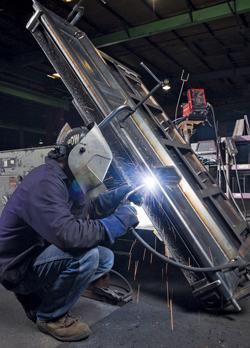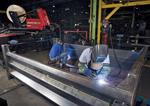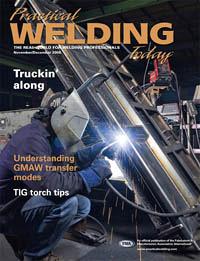- FMA
- The Fabricator
- FABTECH
- Canadian Metalworking
Categories
- Additive Manufacturing
- Aluminum Welding
- Arc Welding
- Assembly and Joining
- Automation and Robotics
- Bending and Forming
- Consumables
- Cutting and Weld Prep
- Electric Vehicles
- En Español
- Finishing
- Hydroforming
- Laser Cutting
- Laser Welding
- Machining
- Manufacturing Software
- Materials Handling
- Metals/Materials
- Oxyfuel Cutting
- Plasma Cutting
- Power Tools
- Punching and Other Holemaking
- Roll Forming
- Safety
- Sawing
- Shearing
- Shop Management
- Testing and Measuring
- Tube and Pipe Fabrication
- Tube and Pipe Production
- Waterjet Cutting
Industry Directory
Webcasts
Podcasts
FAB 40
Advertise
Subscribe
Account Login
Search
Truckin' along
Fabricator 'dumps' spatter, improves deposition with new welding technology
- November 25, 2008
- Article
- Arc Welding

Dump bodies start out upside down and are flipped after the sides are attached. Then the fronthead and tailgate, including hinges, are welded in place.
Truck Bodies & Equipment International (TBEI), Eden Prairie, Minn., a fabricator of dump truck bodies, hoists, and truck and trailer equipment, has established itself as a dominant player in the marketplace with the acquisition of Heil Truck Equipment, Crysteel Manufacturing, Ox Bodies, Rugby, and Hardee Equipment. With these names now under one corporate moniker, TBEI set out to guarantee its brands would continue to dominate the market, as well as evoke fierce loyalty among customers.
"There's only one way to stay ahead of the competition and ensure customers keep coming back—build the best products and stand behind them,"said Greg Stephens, TBEI quality manager.
"You do this by employing the best people and using the best technology and manufacturing processes, Stephens said.
At the company's 10 U.S. manufacturing facilities, the majority of its 1,000 workers are focused on welding. So welding operations were a natural place to start when the company set out to identify opportunities for manufacturing improvement.
At the company's Tishomingo, Miss., plant, which builds approximately 30 Class 1 to Class 8 dump bodies a day, Stephens and his team wanted to improve weld quality by reducing spatter, as well as improve productivity by increasing deposition.
"Our dump bodies start out as enormous flat sheets of steel, so before the completed body rolls off an assembly line, every seam and joint is welded,"Stephens explained. "Our goal was to improve our welding operations so that we could produce more without compromising quality.
"Our dump bodies have to stand up to rigorous and often rough handling by their owners. But we also consider them works of art,"Stephens explained. "They have [to have] nice, smooth sides and clean lines."
Building a Dump Truck Body
Sheets of metal measuring on average 72 inches wide by 102 feet long in thicknesses from 7 to 16 gauge arrive at TBEI's Tishomingo plant to be shaped and formed into various assembly and subassembly configurations. The metal typically is stainless or mild steel, but occasionally is aluminum, depending on the application.
The sheets begin moving through the plant either to be cut into smaller pieces using a hydraulic shear or shaped with a plasma burner. They then move directly to the line or press brake to begin being formed into parts. During assembly, TBEI's dump bodies begin upside down and the sides are attached. Next they are flipped so that the fronthead and tailgate, including hinges, can be welded in place. In fact, welding takes place at nearly every stage of the manufacturing process.
"We had constant concerns with our old welding equipment. We had a lot of spatter and spent too much time on rework, time that could be better spent building more products,"Stephens said.

Click image to view larger TBEI manufactures its dump bodies to withstand the rigors of the job. However, the company also regards them as works of art, which means aesthetically pleasing welds are a must.
Stephens and his team considered a number of welding equipment manufacturers, and chose 25 Lincoln Electric Power Wave® 355M and Power Feed® 10M wire feeder packages with SuperArc® L-50 and Murex® stainless 308LSi wire.
The inverter power source can be used for shielded metal arc welding (SMAW), gas tungsten arc welding (GTAW), gas metal arc welding (GMAW), pulsed and flux-cored arc welding (FCAW), and gouging. The machines gave Stephens and his team the versatility for a variety of processes, which vary based on the job and application.
"We've been able to virtually eliminate spatter, which has considerably reduced the need for grinding and rework. This means more uptime, increased productivity, and faster turnaround time for our welders,"Stephens added. More specifically, Stephens said overall productivity has increased 20 percent.
With so many steps in assembling a dump body, the company wanted to monitor its welding operations. It installed Lincoln's Production Monitoring Software™, which works in partnership with the welding power sources.
The software integrates digital communication to network the welding equipment and makes the data from the shop floor available anywhere, whether from the shop foreman's office or from an engineer's laptop while traveling. TBEI uses Weld Manager™ with a Palm Pilot integrated with the software to control welding procedure limits for its operators.
The software monitors weld settings, weld limits and tolerances, and consumable consumption. It also allows welding machine faults to be logged and e-mailed, while diagnostic troubleshooting can be performed from a remote location.
The power source has Waveform Control Technology™, which gives operators the ability to select the waveform for each application. This allows the arc to be optimized for each wire type and size for improved arc performance. The machines include a Pulse-on-Pulse™ welding mode for improved cleaning when welding aluminum and providing a GTAW-like bead appearance.
TBEI is using its Tishomingo plant as a testing ground for the Lincoln equipment and consumables. Long term, Stephens and his team are considering rolling out the equipment at other TBEI plants.
About the Publication
Related Companies
subscribe now

The Welder, formerly known as Practical Welding Today, is a showcase of the real people who make the products we use and work with every day. This magazine has served the welding community in North America well for more than 20 years.
start your free subscription- Stay connected from anywhere

Easily access valuable industry resources now with full access to the digital edition of The Fabricator.

Easily access valuable industry resources now with full access to the digital edition of The Welder.

Easily access valuable industry resources now with full access to the digital edition of The Tube and Pipe Journal.
- Podcasting
- Podcast:
- The Fabricator Podcast
- Published:
- 04/16/2024
- Running Time:
- 63:29
In this episode of The Fabricator Podcast, Caleb Chamberlain, co-founder and CEO of OSH Cut, discusses his company’s...
- Trending Articles
Sheffield Forgemasters makes global leap in welding technology

Welding student from Utah to represent the U.S. at WorldSkills 2024

Lincoln Electric announces executive appointments

Engine-driven welding machines include integrated air compressors

ESAB unveils Texas facility renovation

- Industry Events
16th Annual Safety Conference
- April 30 - May 1, 2024
- Elgin,
Pipe and Tube Conference
- May 21 - 22, 2024
- Omaha, NE
World-Class Roll Forming Workshop
- June 5 - 6, 2024
- Louisville, KY
Advanced Laser Application Workshop
- June 25 - 27, 2024
- Novi, MI



























